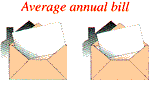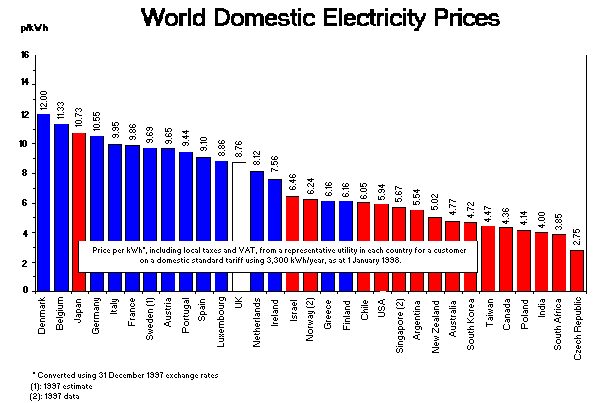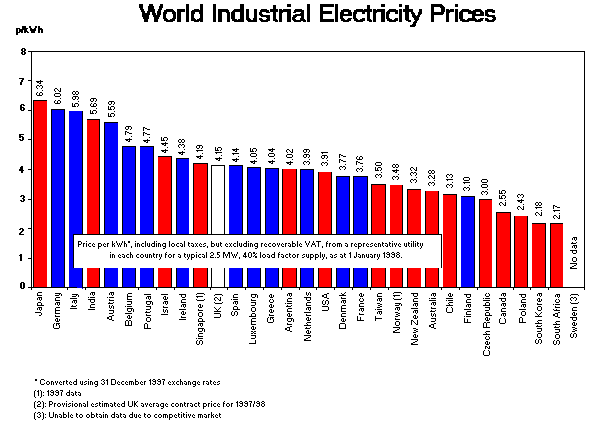イギリスは1998年1月から電力自由化路線を歩んでいるが、ここに紹介するように大きな成果が上がっている。
Prices Latest
9年前と比べて(自由化前)、家庭用で26%も下がっている。自由化が1年前であるから、実際には1年で下がったことになる。
UK domestic electricity prices
 |
The typical UK domestic electricity bill*,
calculated using tariffs at 1 April
1999, is 」256, excluding VAT. This
is a reduction of 」2 on the previous April.
*based on a customer
supplied on a Domestic Standard tariff and
consuming 3,300kWh per year
Comparing April prices over the last nine
years, the cost of domestic electricity has
fallen by 」90, after allowing for inflation
- a fall of 26 percent. The typical
household now pays 74 pence per day (including
VAT) for all its electricity needs in the
home; about the same as two pints of milk
delivered to the doorstep, or a large loaf
of bread.
|
」346
April 1990 |
」256
April 1999 |
産業用でも、下記の3つの使用量モデルで比較すると、30%も下がっている。
UK industrial electricity prices
The Electricity Association also tracks prices
to customers in the industrial sector.
In order to ensure that calculated results
are consistant in methodology, comparable
over time, and to act as a basis for comparison
with other countries, three benchmark loads
are used. Each benchmark has its own
defined levels of maximum demand and load
factor to give a standardised consumption
pattern. The benchmarks are as follows:
| Benchmark |
Maximum demand |
Maximum consumption (MWh/year) |
Annual load factor* |
| A |
500kW |
1,752 |
40% |
| B |
2.5MW |
8,760 |
40% |
| C |
10MW |
52,560 |
60% |
* load factor is defined as the ratio of
the average load, during a specified period,
to the maximum load (maximum demand) during
that period.
Using these models and historic tariff and
contract prices, we have compiled a table
of final-user industrial prices.
Annual Average Results
|
1989/
19901 |
1993/
19941 |
1994/
19951 |
1995/
1996 |
1996/
1997 |
1997/
1998 |
89/90-
97/98
(Real Terms) |
| A |
4.672 |
5.672 |
5.23 |
5.12 |
4.79 |
4.53 |
-28.4 % |
| B |
4.523 |
n/a |
4.54 |
4.51 |
4.29 |
4.12 |
-32.6 % |
| C |
3.924 |
n/a |
3.99 |
4.03 |
3.91 |
3.68 |
-30.7 % |
| RPI5 |
117.4 |
141.5 |
145.4 |
150.1 |
153.7 |
158.8 |
|
1 Source: Electricity Association's International
Electricity Prices Surveys (IEP).
2 Tariff prices (tariffs were generally applied
until March 1994).
3 Tariff prices (tariffs were only applied
to this type of load until March 1990).
4 Special-terms prices (such terms were only
applied until March 1990).
5 Retail Prices Index.
International Electricity Prices
The Electricity Association also carries
out an annual survey of international electricity
prices, to provide an indication how UK prices
compare with european and world electricity
prices.
Each survey is a snapshot of prices at 1
January. The results take several months
to compile and the last results available
are for the survey dated 1 January 1998.
Following below are highlights and press
release extracts from the launch of the survey's
results.
安い電力料金がEU内で競争力を生んでいる。
Low Electricity Prices Give UK Industry the
Edge in Europe
With EU countries opening at least 25 per
cent of their electricity markets to competition
in February 1999, new figures show that the
UK industry is well placed to capitalise,
with some of the lowest power prices in Europe.
Despite the strength of sterling, UK domestic
electricity prices are fifth cheapest of
the 15 EU member countries, the Electricity
Association revealed in its latest edition
of the worldwide comparative prices data
survey International Electricity Prices.
The most recent European figures available
(for 1 January 1998) show that despite the
strength of the pound, the UK remains one
of the cheapest sources of EU electricity.
Prices for a typical domestic customer, allowing
for standing charges and VAT, fell six per
cent in real terms from the previous year
to 8.76 pence per kilowatt hour. That
compared with a price of 12.00 pence per
kilowatt hour in Denmark, the most expensive
nation in the table.
棒グラフの単位はペンス/kWhです。↓

産業用分野では、日本が世界1の高額料金。
In the industrial market, UK electricity
prices under contract are also good value,
halfway among the 15 EU member states.
Prices for a typical medium-sized industrial
user, with a 2.5 megawatt 40 per cent load
factor supply, are 4.15 pence per kilowatt
hour, compared to 6.02 pence for Germany,
the most expensive.
Previous IEP comparisons have found that
European electricity prices tend to be relatively
high compared to prices in other continents
where there may be cheap indigenous fuel
sources available. Notwithstanding
this, and sterling's strengthening against
all but three currencies in the survey (USA,
Chile and Argentina), prices remain well
placed; about halfway in world terms.

Welcoming the findings, Philip Daubeney,
Chief Executive of the Electricity Association
said:
"Britain is leading the world with the
introduction of fully liberalised energy
markets, and our competitive electricity
prices are increasingly becoming the envy
of our European neighbours. UK customers
are enjoying further substantial price reductions
in the competitive market on top of the average
19% real terms price cut already delivered
since privatisation to 1 January 1998.
"This is good news for European customers
who will soon have the opportunity to take
advantage of the UK industry's competitive
prices. Equally it is good news for UK power
companies whose competitive edge is set to
exploit new opportunities as electricity
markets across Europe are progressively opened
to competition.
"We are keen to see other EU Governments
doing more than just the minimum required
in opening their energy markets, to create
a proper level playing field which will benefit
customers across Europe."
インターネット詳細データは下記のWEBサイトを参照ください。

Return to:
Electricity Industry Page


